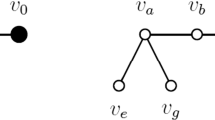Abstract
This paper is devoted to the reduction of decision diagram (DD) representations of discrete functions by using the non-Abelian groups and Fourier DDs on these groups. The number of levels in a DD can be reduced through decomposition of the domain group of the represented function into large subgroups. That approach however increases the number of nodes per levels which may decrease the global reduction possibilities in the DD. At the same time, the nodes with a considerable number of outgoing edges are required. In applications, the complexity, thus the price, of a node is proportional to the number of outgoing edges. From an inspection of optimization methods for DDs representations, it follows that a solution of this problem can hardly be found with DDs on Abelian groups. Therefore, we are proposing the use of Fourier DDs on finite non-Abelian groups.
In that way, the matrix-valued decision diagrams are introduced, since in Fourier DDs on non-Abelian groups some of constant nodes are matrices. These DDs permit two-steps optimization. First we determine the optimal structure of the corresponding decision tree by the reduction of which a DD is derived. The optimization is done with respect to the combination of the number of nodes and levels we may require depending on the application intended. Then, we do the optimization of the representations of matrix-valued constant nodes by ordinary DDs of smaller size. In that way, the complex-valued and integer-valued Fourier DDs are derived depending on the chosen group representations for these applications where the matrix-valued Fourier DDs may not be allowed.
With thus derived Fourier DDs, the reduction of both number of levels and non-terminal nodes may be achieved.
Efficiency of representations with the Fourier DDs on non-Abelian groups is illustrated by the example of DDs representations of n-bit multipliers.
Similar content being viewed by others
References
S.B. Akers, “Binary decision diagrams,” IEEE Trans. on Computers, Vol. C-27, No. 6, pp. 509–516, 1978.
T. Beth, “Generalizing the discrete Fourier transform,” Discrete Mathematics, Vol. 6, pp. 9–100, 1989.
R.E. Bryant, “Graph-based algorithms for Boolean functions manipulation,” IEEE Trans. Comput., Vol. C-35, No. 8, pp. 667–691, 1986.
R.E. Bryant and Y.-A. Chen, “Verification of arithmetic functions with binary moment decision diagrams,” CMU-CS-94-160, May 31, 1994, unpublished paper.
E.M. Clarke, K.L. McMillan, X. Zhao, and M. Fujita, “Spectral transforms for extremely large Boolean functions,” in U. Kebschull, E. Schubert, and W. Rosenstiel (Eds.), Proc. IFIP WG 10.5Workshop on Applications of the Reed-Muller Expansion in Circuit Design, Hamburg, Germany, pp. 86–90, 1993.
E.M. Clarke, M. Fujita, and X. Zhao, “Multi-terminal decision diagrams and hybrid decision diagrams,” in [22], pp. 93–108.
E.M. Clarke, M. Fujita, and W. Weinle, “Hybrid spectral transform diagrams,” in Proc. IEEE Int. Conf. on Information, Communications and Signal Processing, (1st ICICS), Singapore, Sept. 1997,Vol. 1, pp. 251–255.
R. Drechsler, A. Sarabi, M. Theobald, B. Becker, and M.A. Perkowski, “Efficient representations and manipulation of switching functions based on ordered Kronecker functional decision diagrams,” DAC-1994, June 1994, pp. 415–419.
B.J. Falkowski and S. Rahardja, “Complex spectral decision diagrams,” in Proc. 26th IEEE Int. Symp. on Multiple-Valued Logic, Santiago de Campostela, Spain, May 29–31, 1996, pp. 255–260.
M.G. Karpovsky, “Fast Fourier transforms on finite non-Abelian groups,” IEEE Trans. Comput., Vol. C-24, No. 1, pp. 1028–1030, 1977.
U. Kebschull, E. Schubert, and W. Rosenstiel, “Multilevel logic synthesis based on functional decision diagrams,” EDAC 92, pp. 43–47, 1992.
Dj.R. Kurepa, Ensembles ordonnés et ramifiès, (Thèse), Paris, 1935, 6+138+2p.
Dj.R. Kurepa, “Sets-logics-machines,” in Proc. Int. Symp. Theory of Switching, Harvard University, Cambridge, Mass., Pt. 1, April 1957, pp. 137–146.
Y.F. Lai, M. Pedram, and S.B.K. Vrudhula, “EVBDD-based algorithms for integer linear programming, spectral transformation, and functional decomposition,” IEEE Trans. Computer-Aided Design of Integrated Circuits and Systems, Vol. 13, No. 8, pp. 959–975, 1994.
D. Mashen and D. Rockmore, “Generalized FFTs: A survey of some recent results,” in L. Finkelstein and W. Kantor (Eds.), Proc. 1995 DIMACS Workshop in Groups and Computation, 1996.
D. Mashen and D. Rockmore, “Separation of variables and computation of Fourier transform on finite groups,” J. of the Amer. Math. Soc., Vol. 10, No. 1, pp. 163–214, 1997.
S. Minato, “Graph-based representations of discrete functions,” in T. Sasao and M. Fujita (Eds.), Representations of Discrete Functions, Kluwer Academic Publishers, 1996, pp. 1–28.
T. Sasao, Logic Design: Switching Circuit Theory, Kindai Kaga-ku, Tokyo, Japan, 1995, Second Edition, 1998.
T. Sasao, “Representations of logic functions by using EXOR operators,” in T. Sasao and M. Fujita (Eds.), Representations of Discrete Functions, Kluwer Academic Publishers, 1996, pp. 29–54.
T. Sasao and J.T. Butler, “A design method for look-up table type FPGA by pseudo-Kronecker expansions,” in Proc. 24th Int. Symp. on Multiple-valued Logic, Boston, Massachusetts, May 25–27, 1994, pp. 97–104.
T. Sasao and J.T. Butler, “A method to represent multiple-output functions by using multi-valued decision diagrams,” ISMVL-26, pp. 248–254, 1996.
T. Sasao and M. Fujita (Eds.), Representations of Discrete Functions, Kluwer, 1996.
R.S. Stanković, “Matrix interpretation of fast Fourier transforms on finite non-Abelian groups,” in Proc. Int. Conf. on Signal Processing, Beijing/90, Beijing, China, Oct. 22–26, vol. 2, 1990, pp. 1187–1190.
R.S. Stanković, “Fast Fourier transform on finite non-Abelian groups,” in Recent Developments in Abstract Harmonic Analysis with Applications in Signal Processing, Nauka, Belgrade, 1996, pp. 405–420.
R.S. Stanković and T. Sasao, “Decision diagrams for discrete functions: Classification and unified interpretation,” in Proc. Asian and South Pacific Design Automation Conference, ASP-DAC'98, Yokohama, Japan, Feb. 13–17, 1998, pp. 439–446.
R.S. Stanković, T. Sasao, and C. Moraga, “Spectral transform decision diagrams,” in T. Sasao and M. Fujita (Eds.), Representations of Discrete Functions, Kluwer Academic Publishers, 1996, pp. 55–92.
A. Thayse, M. Davio, and J.-P. Deschamps, “Optimization of multiple-valued decision diagrams,” ISMVL-8, pp. 171–177, 1978.
Author information
Authors and Affiliations
Rights and permissions
About this article
Cite this article
Stanković, R.S. Non-Abelian Groups in Optimization of Decision Diagrams Representations of Discrete Functions. Formal Methods in System Design 18, 209–231 (2001). https://doi.org/10.1023/A:1011265018200
Issue Date:
DOI: https://doi.org/10.1023/A:1011265018200




